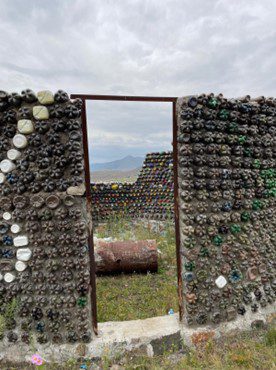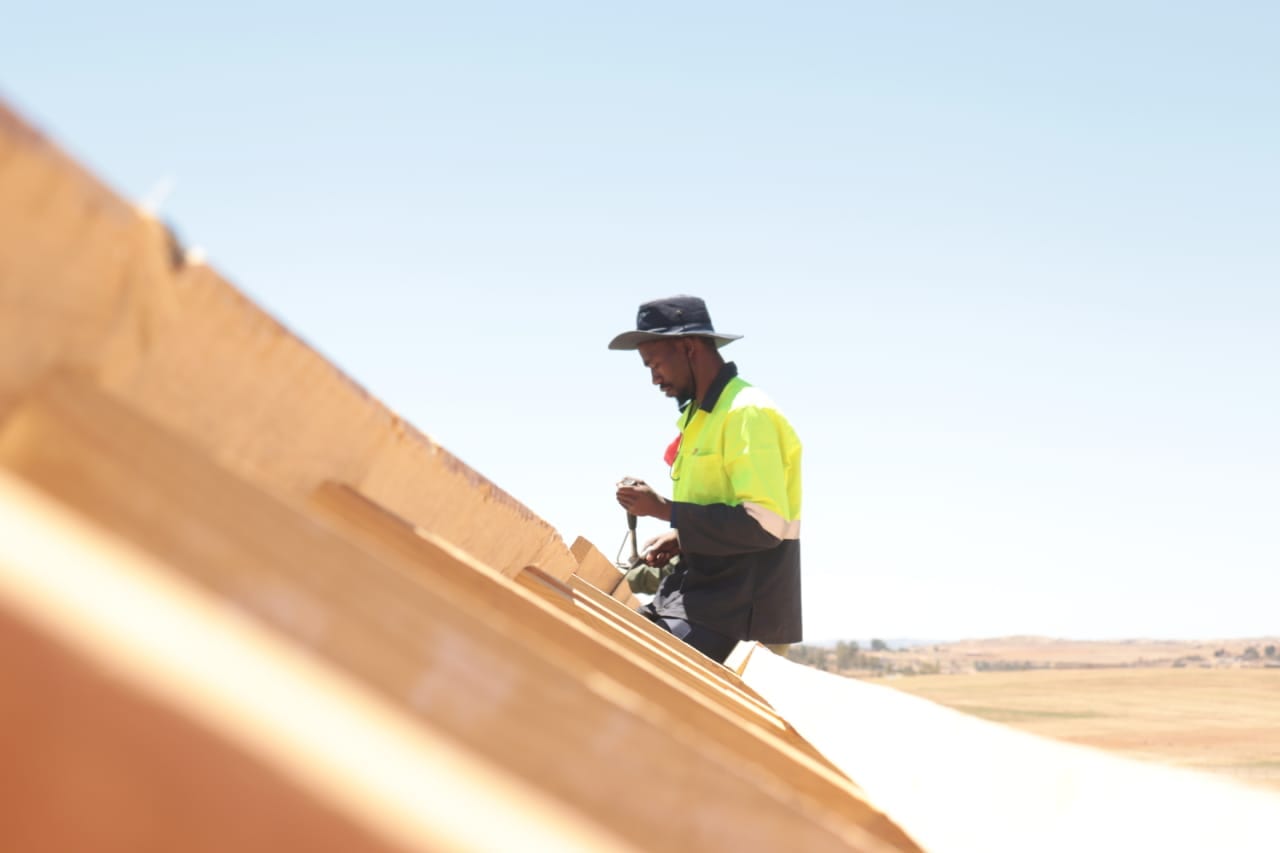Building with Packaging Waste
Desk Research & Primary Findings
Issued on: 30th August 2023
1. Background
1.1.Overview of Waste as a Building Material
The world’s industrial development and economic growth have resulted in a significant increase in solid waste, including plastic, cans, glass bottles, and paper, which pollute the environment by ending up in oceans and landfills (Vicelj, Sandanayake & Yap, 2022). Lesotho is no exception as it is facing a massive waste disposal management crisis that it cannot manage, with only 20% of waste being collected, and the remaining 80% being dumped illegally, plus an increasing amount of waste generated by growing commercial and household activities.
The Lesotho government’s strategy, as outlined in the National Environmental Policy 1998 and the Environmental Act 2008, is to design environmentally friendly waste disposal and treatment systems that encourage recycling. The building sector is constantly evolving in its use of materials with regard to sustainability. There is a need to use cost-effective, environmentally friendly materials and technologies that lessen the impact of construction in terms of its use of non-renewable resources. Hence, Lesotho has an opportunity to use waste materials such as glass bottles, cans, and plastics as construction materials, to address the need to manage waste (UNDP, 2021).
2. Categories of Waste Material for the Built Industry
Explored in this paper are four common waste materials; glass bottles, metal cans, plastic waste, and paper. All four were analysed according to the following areas:
- Potential and/or evidence of use as a building material
- Locally available
- The potential of a sustained “affordable” supply of the material
- Environmental impact on the re-purposing of the waste into building materials
2.1 Glass Bottles Used as a Building Material
To address Lesotho’s housing needs and waste management issues compounded by rural-urban migration and using glass as a building material can be a viable solution (UNDP, 2021). This technique has been used for centuries, with the ancient Romans using empty glass vessels to reduce concrete usage and lighten the load of upper levels of structures (Fatima, 2017). William F. Peck constructed the first glass bottle house in 1902 using 10,000 bottles (See Figures 1.1 & 1.2). Glass houses in South Africa by Kevin Kimwelle assisted the government in providing secure housing with construction that comprised 80% recycled materials.

Fig.1.1: A sample glass building

2.1.1 Techniques Used When Building with Glass
According to Fatima (2017), glass bottles are to be collected and sorted. About 14,000 bottles of uniform size are needed to make a two-bedroom bottle home. The walls can be made in many different ways, but are typically constructed by making a foundation filled with reinforcing bars (rebar); preferably metal that can be set to add stability to the structure. The walls are usually one or two bottles thick (Fatima, 2017). These walls function as a thermal mass when the glass bottles are filled with dark materials such as sand so as to absorb the solar radiation during the day and radiate it into the interior during the night. This feature can be pleasant in cooler climates but can turn a room into an oven in hot climates.
2.1.2. Advantages of Glass Bottles Buildings
The benefits of building with glass are that it is low cost, decreases the use of binding material and reduces landfill mass by making the bottle a renewable material (Fatima, 2017). Furthermore, glass bottles offer various aesthetics due to their opacity and color selection which creates an alternative to plastering. Fatima (2017), further states that the use of glass bottles could help increase the accessibility to houses due to their near-modular nature in comparison to conventional building methods.
Housing for economically disadvantaged households could be made more affordable by using glass buildings, which are estimated to cost only a third of the cost of a house made of concrete and bricks (Rukami, 2021). Glass bottle walls offer excellent thermal insulation because of the hollow bottles. A single layer of bottle walls can provide the same lagging as a three-layer brick wall. The walls also allow natural light to pass through when not filled with dark materials, providing natural lighting to the room if necessary (Rukami, 2021). It is also a waterproof and impervious material, making it a suitable material for building homes. Sharma (2017) suggests using glass bottles to build small houses as a means of reducing the amount of waste going to landfill.
2.1.3. Disadvantages of Glass Bottles
Without tempering or structural support, glass has poor resistance to impact, and is therefore unable to withstand an immediate load, which may result in breakage upon pressure or impact. Furthermore, it requires frequent cleaning, and in high-rise buildings, maintaining and cleaning the exterior can be difficult. The extensive use of glass may give rise to both real and perceived security concerns (Khanlari, Tuncer, Afshari & Socen, 2023).
As mentioned above, a glass wall is also an excellent conductor of heat with the potential of creating hotspots through a lens effect. In contrast, cold nights can also result in considerable heat loss because of the nature of glass.
2.2. Metal Cans Used as a Building Material
According to the UNDP (2021), metal cans make up 15% of waste in urban areas in Lesotho. As reported by Amosu in 2002, Michael Hönes, a German national who relocated to Lesotho, is credited with introducing the technique of utilizing cans in construction, and he is believed to have built the first can building in the country. (See Figure 2.1 and Figure 2.2)


2.2.1. Application of Metal Cans
A popular way of utilizing cans in construction is by using the earthship wall technique, where the cans are horizontally stacked in a concrete matrix. The cans are laid side by side in alternating rows like bricks, with the concrete being thick enough to hold the cans in place. This method involves repeating the pattern of can-concrete-can until the wall is finished. To finish off the wall, it is typically covered with a layer of cement or adobe mixture, which varies depending on the location of the wall, such as a bathroom or bedroom (Khanlari, Tuncer, Afshari, & Socen, 2023). Alternatives to these include flattening the cans to layer them.
2.2.2. Advantages of Metal Cans
The process of creating blueprints and assembling the structure is relatively quick, which contributes to its affordability (Khanlari, Tuncer, Afshari & Socen, 2023). Additionally, metal cans provide good insulation, which can increase energy efficiency and lead to lower heating and cooling costs. Metal cans are highly durable building materials that can withstand severe weather conditions, including high winds, heavy snow, lightning, and hail. Moreover, metal can structures are an eco-friendly option compared to other building materials, as they are fully recyclable and require less energy to produce. Constructing tin can walls does not require advanced construction skills (Parker & Akbari, 2013).
2.2.3. Disadvantages of Metal Cans
According to Khanlari, Tuncer, Afshari & Socen (2023), the metal can wall technique is not load-bearing. Without support, metal cans can also buckle under pressure and collapse if they are not filled with earth or sand. In addition to this, most cans are prone to weather and atmospheric conditions[1] [2] which could lead to corrosion if otherwise left unshielded. Another consideration is that of soundproofing in which case metal cans perform rather poorly against rain, hail, and even windstorms.
2.3. Plastic as a Building Material
Solid plastic waste has properties that make it a viable alternative building material. Plastic waste in Lesotho constitutes 69% of the solid waste, and due to high economic activity, it is available and accessible in many urban areas (Kumar, Biswas & Debarashi, 2020). This type of waste increases rapidly and is projected to continue to do so until there are controls in place for their use. There are two forms of plastic that are explored in some detail; plastic bricks which are repurposed recycled plastic material formed into standard-sized bricks and plastic bottles are used whole or in part for their structure and ability to hold other earth and other materials.
2.3.1. Plastic Bricks as a Building Material
These are already produced in Lesotho using a specialized manufacturing process to make standard-sized bricks. In order to make the bricks, plastic waste is first collected and separated by type. It is then treated, cleaned, and dried to remove any debris and moisture. The plastic bags and bottles are then melted at a temperature between 120-150 degrees Celsius, in a closed vessel to prevent the release of toxic gasses (Kumar, Biswas & Debarashi, 2020). Once the plastic is melted, river sand is added to the mixture and thoroughly mixed. According to Kumar (2020), the mixture is then poured into molds and left to cure for 2 days before being removed. (See Figure 3.1 & 3.2 ).


2.3.1.1. Advantages of Plastic Bricks
Utilizing plastic waste to produce bricks offers benefits such as reducing the amount of plastic going to landfills or ending up in Lesotho’s rivers and lakes and cutting down the need for resources used in other building materials like clay and cement. The built industry’s carbon footprint is thus reduced, with the potential to drive the growth of waste plastic bricks in the market (Kumar, Biswas & Debarashi, 2020). The demand for plastic bricks has increased exponentially due to rapid urbanization in recent years, making waste plastic in brick production a viable new business and employment opportunity. By replacing clay or cement with waste plastic, the strength and durability of bricks are not severely compromised (Kumar, Biswas & Debarashi, 2020).
The production cost of plastic bricks can be reduced by reusing waste polyethylene, which is more cost-effective and eco-friendly than using costly brick earth. Digging brick earth can have environmental consequences, and utilizing plastic waste instead can help address this issue (Kumar, Biswas & Debarashi, 2020). Plastic bricks have a smooth finish, low water absorption value, and are resistant to problems such as efflorescence, making them a desirable alternative to traditional bricks (Kumar, Biswas & Debarashi, 2020).
2.3.1.2. Disadvantages of Plastic Bricks
As per Kumar (2020), plastic bricks may be used in partitioning and exterior use only. Their average compressive strength when using the process above is 5MPa which means they cannot be used as load-bearing bricks. Secondly, the manufacturing process for these bricks yields toxic gases which contribute to air pollution. It is a process that requires high temperatures which also have environmental implications. Lastly, because of the mechanical nature of this process, there is specialized equipment that requires the importation of materials to Lesotho and skills to execute properly.
2.3.2. Building with Plastic Bottles
According to Froese (2017), it is possible to utilize plastic bottles as a substitute for bricks by filling them with either soil or sand, which enables them to function as building blocks for walls or pillars. Varying sizes and orientations of PET bottle walls can be constructed, and when filled with sand, these walls can bear up to 4.3 N/mm². While the plaster is responsible for two-thirds of the load, the bottles bear one-third. The space between the bottles is filled with plaster made of either clay or a cement mixture. Since only locally sourced materials are used, these houses are inexpensive and can be afforded even by impoverished families. Moreover, the construction process is relatively fast, and the first bottle house in the country was built in Mokhotlong (refer to Figures 4.1. and 4.2).


2.3.2.1. Advantages of Plastic Bottles as a Building Material
In Lamba’s (2021) research, it is noted that utilizing plastic bottles as building materials provides various advantages such as durability, lightweight, water resistance, high elasticity, strength, corrosion resistance, and affordability. Compared to brick walls, plastic bottle walls filled with sand require less equipment and material costs, and also require less labor (Lamba, Kaur, Raj & Sorou, 2021). Reusing plastic bottles in construction projects has been shown to be effective in saving energy and reducing CO2 emissions by decreasing the percentage of cement used in manufacturing concrete blocks, according to Mojtaba et al (2012). The use of plastic bottle buildings has been recognized as a green project in the architecture and construction industry (Mojtaba et al, 2012) by elongating the life cycle of the material.
Furthermore, bottle houses are designed to be bioclimatic, which means that they are warm inside during cold weather and cool inside during warm weather (Mojtaba et al, 2012). The separation of various cost components indicates that using local labor to make bottle panels can result in a 75% cost reduction compared to building walls with bricks and concrete blocks (Lamba, Kaur, Raj & Sorou 2021).
The attribute of flexibility is known to enhance a building’s ability to withstand unexpected loads. Plastic bottles, being non-fragile, can exhibit flexibility and withstand sudden loads without failure, thereby improving the building’s load-bearing capacity. Moreover, plastic bottle walls have a water absorption rate of zero percent (Lamba, Kaur, Raj & Sorou, 2021).
2.3.2.2. Disadvantages of Plastic Buildings
There are concerns regarding the durability of recycled plastic bottles due to photodegradation caused by exposure to UV light. This degradation process can lead to reduced strength and increased brittleness over time, as well as the release of harmful toxins and microplastics that could potentially affect the health of occupants or contaminate groundwater (Sharma & Chandel 2017). Some argue that using plastic waste to create building materials may exacerbate the issue of plastic waste. It is important to note that plastic is a combustible material and can release toxic gasses in case of fire, posing a risk to occupants and the environment (Sharma & Chandel. 2017)
Unplastered or unrendered plastic bottle houses may have an unconventional appearance that is sometimes associated with poverty, and building and planning regulations may not permit them in certain jurisdictions, as pointed out by Sharma & Chandel, 2017.
2.4. Cellulose Paper Fiber
Energy efficiency in buildings is an important factor for the extreme temperate climate in Lesotho. The building and construction sector accounts for 30% – 40% of worldwide energy consumption, with a large part belonging to the need to heat and cool buildings. There are traditional insulation materials such as glass fiber, stone wool, expanded polystyrene, and polyurethane foam (Hurtado, Antoine & Virginie, 2015). While they are efficient in maintaining thermal comfort to the interior of a building, they are made with non-renewable resources and have a high embodied energy. Consequently, this has resulted in an increasing interest in alternative insulating materials that come from renewable or recycled fiber such as cellulose (Hurtado, Antoine & Virginie, 2015).
Cellulose is an eco-friendly thermal insulating material that has been around for centuries and has been used to insulate unfinished attic floors and existing closed walls. More than 70% of modern cellulose insulation is made from recycled newsprint, cardboard, and other paper types (Hurtado, Antoine & Virginie, 2015). However, in Lesotho cellulose insulation has not been widely used in comparison to the more traditional insulation materials.
2.4.1. Advantages of Cellulose Paper Fiber
Cellulose fiber has a low environmental impact, low embodied energy, and has similar insulation properties to synthetic materials. Greenhouse gas emissions and embodied energy of the buildings are reduced by up to 15% by replacing the rock wool insulation material with cellulose fiber (Hurtado, Antoine & Virginie, 2015).
The use of lightweight cellulosic paper as reinforcement in low-cost building materials is an interesting strategy for managing these by-products. Their functional properties, environmental and socio-economic benefits, and overall availability propose an appealing alternative. The indoor air humidity and comfort are affected appreciably by the transport of moisture between hygroscopic insulation and the indoor air. The indoor moisture buffering effect can be enhanced by employing high-density cellulose fiber insulation on the inner side of the buildings (Hurtado, Antoine & Virginie, 2015).
2.4.2. Disadvantage of Cellulose Paper Fiber
Cellulose insulation is known to absorb moisture easily, which can be a severe problem if a pipe bursts or if there is a bad leak in the plumbing. While other forms of insulation hold the excess moisture on the surface, cellulose absorbs it entirely. In fact, cellulose can absorb as much as 130% moisture by weight.
Furthermore, the material dries very slowly once the water is absorbed, leading to settling, deterioration, and mold growth. Too much water absorption can even destroy the chemical fire treatment for which cellulose is so well known (Hospodarova, Stevulova, and Sicakova, 2015)
It is prone to sagging and settling, a problem further exacerbated by the fact that it is several times heavier than comparable insulating materials, like fiberglass. The greater weight of cellulose naturally means that it is affected by gravity more than other materials, reducing the R-value of the insulation as the material sags and settles over the years (Hospodarova, Stevulova, and Sicakova, 2015)
3. Primary Explorative Research Findings on Packaging Waste
3.1. Research Methodology
To collect primary data, stratified and snowball sampling were convenient techniques for this study. It was imperative to undertake interviews with professionals and experts with over 10 years of experience, knowledge, and skills working with packaging waste, and the built industry in particular. This chapter presents a total of 15 interviews conducted from January to June 2023, the researchers conducted face-to-face interviews that lasted between 45 minutes to 1 hour each. Qualitative surveys (Check here for the Research Questions)[1] were used to gain in-depth information, experiences, and narratives about some specific topics such as availability, accessibility, cost, durability, and environmental impact of extraction.
3.1.1. Availability of Packaging Waste
The purpose of the interview was to understand the availability of collected and unaccounted waste (cans, paper, plastic, and glass) in urban areas. Also to know the availability of plastic bricks produced in the country and the chain of supply of plastic needed to make the plastic bricks. To know the number of companies already building using plastic bricks. Fifteen of the Respondents showed that the proximity to urban areas does not guarantee the availability of waste (plastic, cans, paper & glass). Using Maseru as a case, the respondents stated that this is because only 20% of household waste is picked up by companies that get paid to collect it. The majority of the rest is collected by the Maseru City Council to take it to a landfill. This waste is accessible to select companies given authority by the officials and this limits who and what can be done with it.
Additionally, the respondents stated that of the waste collected, 69% of the plastic is sold to KHY Plastic recycling company. The Respondents indicated that waste (plastic, paper & cans) is seen as a means of income which in turn reduces the supply of waste to be used for building. Furthermore, the respondents stipulated that of the 80% unaccounted waste, burning is one of the biggest culprits, followed by illegal dumping. Respondents further specified limitations to waste available for the built environment has resulted in plastic bricks companies capping production at 500 units per week. This fails to meet the demands in the construction of houses. Therefore, proper management of waste is required, as well as introducing community members to other uses of waste especially in the built environment.
3.1.2. Cost of Packaging Waste
It was important to know the costs incurred during the collection, production, building and the selling price of the material. In costing these materials the respondents only considered plastic bricks since all other options were either theoretical or at the testing phase. Three Respondents showed that the overall cost of production, from collection to processing and building, is relatively cheap with variations by the type of waste and location. This is because waste is free when collected from illegal disposal sites and around villages. Also, the respondents (plastic brick suppliers) stipulated that there are existing alternative and competing marketplaces for trading plastic, paper, and cans while glass waste remains untapped and has been known to be given out for free. After selling to the KHY Plastic recycling company, surplus plastic costs M0.50 (EUR0.025) when it’s coloured and M1.50 (EUR0.075) when it’s white or transparent. This is the range of costs during the acquisition phase.
Additionally, during the production phase, three of the Respondents who manufacture plastic bricks disclosed that when producing plastic bricks they use open fires as they have not invested in buying machinery to keep initial investment capital costs low. Additionally, the Respondents indicated that the associated operational costs in producing the plastic bricks are cheap or free at this proof-of-concept stage. The Respondents indicated that they recognize that this limits production and they would need to significantly invest should they pursue growth via industrial production. This would require a minimum capital investment of M75 000 (EUR 3750) at the time of the interview to buy machinery. Lastly, labour costs are kept relatively low because there is minimal skill required under effective supervision.
Furthermore, it was important to know the selling price of plastic bricks from the already existing producers of the bricks in the country before advocating for it in comparison to conventional building materials. Twelve of the Respondents showed that in comparison with conventional paving bricks, plastic bricks are more expensive stipulating that paving bricks are M5.00 (EUR0.25) while concrete paving bricks are M2.50 (EUR0.13) each, but there are long-term benefits of using plastic bricks because the bricks require less maintenance and replacement, unlike conventional paving bricks.
3.1.3 Environmental Impact of Packaging Waste
It was important to know the impact of the production of plastic bricks, changing climatic conditions, and the benefits of using waste as building materials to the environment. Nine of the Respondents showed that the use of plastics, cans, glass, and cellulose paper has a tremendous impact on the environment due to the changing climatic conditions. Respondents emphasized that using plastic, paper, metal cans, and glass reduces the amount of waste and protects the environment from waste through repurposing of the materials.
Also with the changing climatic conditions, plastic bricks can be used to build bridges and roads as the plastic bricks are water resistant unlike concrete blocks and paving bricks which are easily damaged by floods. Additionally, Respondents showed that because of the cold winters that are experienced in the country cellulose insulation could contribute to thermal efficiency. Three of the Respondents conveyed that during the production phase of plastic bricks, there is a documented negative impact, in that the plastic is burned using wood or charcoal which leads to the emission of toxic gasses into the atmosphere. As a result, some Respondents are trying to shift away from burning plastic to purchasing the required machinery.
4. Feasibility of Packaging Waste
The respondents indicated that waste as a building material may cover an unfulfilled need for proper structures and affordable housing for urban populations since urban areas are where packaging waste is more readily available than in rural areas. The opportunity they see is a reduction of poorly constructed houses and slums. They also mentioned that due to concerns about the inability of packaging waste materials to be load-bearing, most packaging waste solutions can be incorporated with traditional construction materials for their superior thermal performance.
However, the Respondents expressed a concern regarding a shortage of skills needed to produce and use packaging waste products. Due to the theoretical or illustrative nature of these houses and products in Lesotho and South Africa, there is a concern from potential investors and entrepreneurs. At this stage, both on the supply side and demand side, Basotho’s perception of waste as a building material is that it is not a feasible value chain. The Respondents indicated that the competing industries such as KHY plastics, Mookoli scrapyard, and Ha Mokotso which takes 72 tonnes 12 times in a month perhaps because of their stage in maturity, have cornered the collectors and distributors market which bodes poorly for the built industry.
5. Distribution of Packaging Waste
20% of the waste in Lesotho goes to collection systems and recycling companies and 80% goes to illegal dumpsites. It could be diverted directly to entrepreneurs working towards promoting sustainable building materials as a way to design environmentally friendly waste disposal methods. Plastic, paper, and metal cans don’t require specialized transportation, care, or packaging which means processing plants and collection services can be set up for construction sites fairly easily. Glass bottles, however, are fragile, and require care and packaging. The largest bottleneck to the distribution of packaging waste is the legal framework which dictates who can pick it up from landfills under current policy.
6. Unmet needs on Packaging Waste as a Building Material
Exploring waste as a building material has not been introduced in full capacity as yet in the country as only a few unregistered companies have started using waste in the building industry, therefore its potential to be used and seen as a viable building material in Lesotho remains unknown. Also, the lack of documented reports about the exact number of plastic bottles, cans, and glass bottles going to landfill remains undocumented. The 80% of unaccounted waste could play a role in using waste as a construction material at an industrial scale. The lack of building codes especially for the use of recyclable construction material such as waste is a major restraint in the growth of the industry.
7. Conclusions
A significant consideration when looking at these packaging waste materials is the life-cycle cost to the environment in their production and use. By lengthening the life cycle of these materials, we’re effectively reducing the burden of its environmental impact by averaging it over a longer lifespan. This research was conducted comparative to currently used alternatives and the embodied carbon in these materials cannot be ignored. However, since we are considering these materials under the current policy in Lesotho, with the vision that the importation of many of these materials may change in the future, we cannot explore a quantitative approach to the environmental cost-benefit analysis of using them as an alternative.
Millions of metal cans, plastic, paper, and glass bottles are discarded every year into landfills, illegal dumping sites, or rivers. Sustainable reuse of packaging waste is mutually beneficial for both the environment as well as the construction industry. These construction techniques and materials and the associated benefits need to be promoted through educating the local community since they are the ones who will benefit the most from this low-cost construction. However, concerns linger over the viability and sustainability of businesses around their use in the built industry.
8. Recommendations
There are two considerations to make when assessing whether there is a feasible application of packaging waste as construction material. The first is whether businesses in this value chain are viable, and the second is whether they are sustainable. Since the only material explored beyond the demonstrative and proof-of-concept stages is the plastic brick, we shall focus on it in our recommendations.
From an environmental perspective, it is prudent to rule out the possibility that the impact of toxic byproducts does not outweigh the benefits of extending their life cycle. From an economic point of view, there are existing industries, such as fashion and homeware(Pheha Plastic), that pull some away from the supply base. But, from an optimistic perspective, this means there are supportive services around the transportation, distribution, and warehousing of packaging waste which can be diverted through better incentives from the built industry. The pricing of plastic bricks needs to be adjusted to scale since the current plants are too small to create a product that can compete with traditional bricks.
Colombian-based Conceptos Plasticos suggested that entry into the plastic brick construction industry should target institutionally supported and large projects. They mentioned that due to the high prices, it would be necessary to lobby large NGOs and international partners in Lesotho to back the use of plastic bricks by looking at their extended life-cycle in the built industry. Since these multilateral and multinational organizations have varied interests in Lesotho, it might be a strategic approach to highlight the socio-economic, financial, and environmental benefits of plastic bricks which checks boxes for their own in-country operations. They added that large construction projects like schools, pavements, and shelters would make for a compelling financial case due to the economies of scale.
As a secondary recommendation, processing cellulose paper seems like a low-hanging fruit for institutions to explore to create a competitive product in the insulation space.
Government is a key actor in the value chain of packaging waste and there are several things that can be done by the government in order for packaging waste to potentially become a feasible and accessible building material:
- Building codes can be amended to promote and encourage the use of packaging waste as a building material.
- The government can promote innovation so that packaging waste can be encouraged to be used more in buildings by supporting initiatives that introduce this innovation to the community at large.
- There needs to be enforcement of government policies around waste management. This includes punishing offenders at illegal dumpsites and promoting the sorting of waste at waste management plants.
Government should track waste management activities as one platform by using a set of matrices making it easy to share and report information with stakeholders about the amount of waste available.
9. Appendices
Appendix A: List of Key Respondents
| Respondent No | Name of Company/ Profession | Number of years of Experience | Profession |
| Respondent 1 | Plastic Brick Producer | 3 years | Individual brick contractor/Plastic brick maker |
| Respondent 2 | Pheha Plastic | 5 years | Founder |
| Respondent 3 | Ministry of Environment | 10 years | Environmental spet |
| Respondent 4 | Maseru City Council | 10 Years | Waste manager at MCC |
| Respondent 5 | Nebulart Company | 9 years | Designers of Plastic Brick making machine |
| Respondent 6 | Organo-Pharma Ltd | 5 years | Plastic brick constructor |
| Respondent 7 | Boloka Bohloeki | 16 years | Owns the company that in charge of the waste site Associations of Waste |
| Respondent 8 | Solar lights | 15 years | Architect who built using metal for |
| Respondent 9 | Upscaling low-income houses ( Community architect | 18 years | Architect in South Africa who works on upscaling |
| Respondent 10 | Nomsa Plastic brick | 1year | Plastic brick producer |
| Respondent 11 | KHY Plastic ( plastic recycling company) | 18 years | Owner of the recycling plastic company in Lesotho |
| Respondent 12 | UNDP | 7 years | Environmental Spet |
| Respondent 13 | Cape Insulation | 11 years | Professional Cellulose installer and marketing personal for the companyl |
| Respondent 14 | Mookoli scrap yard ( collect paper | 3 years | Entrepreneur and Founder of a recycling company |
| Respondent 15 | Carton | 6 years | Employee of Carton |
10. Bibliography
Amosu, A. 2002. Lesotho: Recycling Tin Cans into Houses. https://allafrica.com/stories/200209170001.html
Hospodarova, V . Stevulova, N & Sicakova, A. 2015. Possibilities of Using Cellulose Fibres in Building Materials https://iopscience.iop.org/article/10.1088/1757-899X/96/1/012025
Hurtado, L. Antoine, R. Virginie, V. & Christine, D. 2015. A Review on the Properties of Cellulose Fiber Insulation. https://www.researchgate.net/publication/284232857_A_review_on_the_properties_of_cellulose_fibre_insulation
Attainable Home, 2022. Cellulose Insulation Pros and Cons (loose -Fill and Sprayed) https://www.attainablehome.com/cellulose-insulation-pros-and-cons/
Fatima, S. 2017. Study of Material Flow Analysis of Paper Waste in Municipal Solid Waste of Lahore Cantonment. https://neptjournal.com/upload-images/NL-53-20-(18)D-224.pdf
Lesotho Vision, 2020/ UNEP Law and Environment https://leap.unep.org/countries/ls/national-legislation/lesotho-vision-2020
Khanlari, A. Tuncer, D. Faraz, A. & Socen, G. 2023. Utilization of Recyclable Aluminum Cans as Fins in Vertical Solar Air Heating System: An Experimental and Study. https://www.sciencedirect.com/science/article/pii/S2352710222014528
Kumar, A. Biswas, M. & Debarashi, N. 2020. A Study of Manufacturing Bricks Using Plastic Waste. https://www.jetir.org/papers/JETIR2008243.pdf
Lamba,P. Kaur,D. & Raj, S. 2022. Recycling/ reuse of Plastic waste as construction material for sustainable development: a review. https://link.springer.com/article/10.1007/s11356-021-16980-y
Mojtaba,V. & Masoud, V. 2022. Investigating the Application of Plastic Bottles as a Sustainable Material in Building Construction. https://www.researchgate.net/publication/320988328_Investigating_the_Application_of_Plastic_Bottle_as_a_Sustainable_Material_in_the_Building_Construjtabaction
Mdrezaur, R. & Muhammad,K. 2022. Extraction Types and Classification of Cellulose. https://www.sciencedirect.com/science/article/abs/pii/B9780323857710000038
Sharma, K. & Chandel, M. 2017. Life Cycle Assessment of Potential Municipal Solid Waste Management Strategies for Mumbai, India. https://journals.sagepub.com/doi/abs/10.1177/0734242X16675683
Sandanayake, M. Yanni, B. & Vrcelj, Z. 2022. Current Sustainable Trends of Using Waste Materials in Concrete-A Decade Review. https://www.semanticscholar.org/paper/Current-Sustainable-Trends-of-Using-Waste-Materials-Sandanayake-Bouras/7fea5f0303321116db1ce88b9ef8db61972827de
UNDP, 2021. Lesotho Annual Country Report 2020 Country Strategic Plan. https://lesotho.un.org/en/145108-lesotho-annual-country-report-2020
Viola, H. & Nadezda, S. 2015. Cellulose Fibers Used in Building Materials. https://www.researchgate.net/publication/300400574_Cellulose_Fibres_Used_in_Building_Materials










